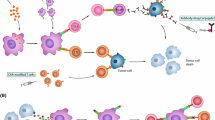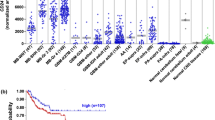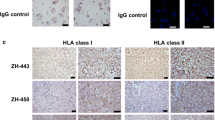Abstract
We raised an anti-glioma monoclonal antibody, named G-22, that specifically recognizes a human gliomaassociated surface antigen. Proven to be useful for target imaging of malignant gliomas after radioisotope labeling and cerebrospinal fluid diagnosis by enzyme-linked immunospecific assay, G-22 was found to immunoprecipitate an 83-kDa glycoprotein of the human glioma U-251MG cell. We purified this antigen by G-22-coupled cyanogenbromide-activated Sepharose affinity chromatography, and sequence analysis demonstrated that the 54 amino acid residues were identical to positions 55–108 of human CD44. The results show that the smallest spliced form (85 kDa) of CD44 is strongly expressed in glioma cells.
Similar content being viewed by others
References
Asher R, Bignami A (1991) Localization of hyaluronate in primary glial cell cultures derived from newborn rat brain. Exp Cell Res 195: 401–411
Asher R, Bignami A (1992) Hyaluronate binding and CD44 expression in human glioblastoma cells and astrocytes. Exp Cell Res 203: 80–90
Goldstein LA, Zuhou DEH, Picker LJ, Minty CN, Bargatze RF, Ding JF, Butcher EC (1989) A human lymphocyte homing receptor, the Hermes antigen, is related to cartilage proteoglycan core and link proteins. Cell 56: 1063–1072
Gunthert U, Hoffman M, Rudy W, Reber S, Zöller M, Ponta H, Herrlich P (1991) A new variant of glycoprotein CD44 confers metastatic potential to rat carcinoma cells. Cell 65: 13–24
Herrlich P, Zöller M, Pals ST, Ponta H (1993) CD44 splice variants: metastases meet lymphocytes. Immunol Today 14: 395–399
Jackson DG, Buckley J, Bell JI (1992) Multiple variants of the human lymphocyte homing receptor CD44 generated by insertions at a single site in the extracellular domain. J Biol Chem 267: 4732–4739
Kuppner MC, Van ME, Gauthier T, Hamou MF, Tribolet N (1992) Differential expression of the CD44 molecule in human brain tumors. Int J Cancer 50: 572–577
Li H, Hamou MF, Tribolet N, Jaufeerally R, Hofmann M, Diserens AC, Van Meir EG (1993) Variant CD44 adhesion molecules are expressed in human brain metastasis but not in glioblastomas. Cancer Res 53: 5345–5349
Mizuno M, Yoshida J, Yagi K (1990) Growth inhibition of glioma cells transfected with the human β-interferon gene liposomes coupled with a monoclonal antibody. Cancer Res 50: 7826–7829
Screaton GR, Bell MV, Jackson DG, Cornelis FB, Gerth U, Bell JI (1992) Genomic structure of DNA encoding the lymphocyte homing receptor CD44 reveals at least 12 alternatively spliced exons. Proc Natl Acad Sci USA 89: 12160–12164
Stamenkovic I, Amiot M, Pesando JN, Seed B (1989) A lymphocyte molecule implicated in lymph node homing is a member of the cartilage link protein family. Cell 56: 1057–1062
Stamenkovic I, Aruffo A, Amiot M Seed B (1991) The hematopoietic and epithelial forms of CD44 are distinct polypeptides with different adhesion potentials for hyaluronate-bearing cells. EMBO J 10: 343–348
Stone KL, LoPresti MB, Crawford JM, DeAngelis R, Williams KR (1989) Enzymatic digestion of proteins and HPLC peptide isolation in the subnanomole range. In: Matsudaira PT (ed) A practical guide to protein and peptide purification for microsequencing. Academic Press. New York, p 39
Wakabayashi T, Yoshida J, Seo H, Kazo K, Murata Y, Matsui N, Kageyama N (1988) Characterization of neuroectodermal antigen by a monoclonal antibody and its application in CSF diagnosis of human glioma. J Neurosurg 68: 449–455
Wakabayashi T, Yoshida J, Ohshima N, Sugita K (1992) The clinical application of monoclonal antibody to the tumor-imaging system. Prog CI 14: 435–440
Yoshida J, Yamamoto R, Wakabayashi T, Nagata M, Seo H (1990) Radioimmunoassay of glioma-associated antigen in cerebrospinal fluid and its usefulness for the diagnosis and monitoring of human glioma. J Neurooncol 8: 23–31
Yoshida J, Mizuno M, Inoue I, Wakabayashi T, Sugita K, Seo H, Chiba K (1990) Radioimaging of human glioma xenografts with123I labeled monoclonal antibody G-22 against glioma-associated antigen. J Neurooncol 8: 221–229
Yoshida J, Mizuno M, Yagi K (1992) Antitumor effect of endogenous human β-interferon on malignant glioma and augmentation of the effect by tumor necrosis factor-α. J Clin Biochem Nutr 12: 153–160
Author information
Authors and Affiliations
Rights and permissions
About this article
Cite this article
Okada, H., Yoshida, J., Seo, H. et al. Anti-(glioma surface antigen) monoclonal antibody G-22 recognizes overexpressed CD44 in glioma cells. Cancer Immunol Immunother 39, 313–317 (1994). https://doi.org/10.1007/BF01519984
Received:
Accepted:
Issue Date:
DOI: https://doi.org/10.1007/BF01519984




